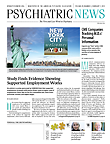A small but statistically significant association has been found between hospital admissions for infections of all kinds throughout childhood and a later diagnosis of nonaffective psychosis.
This association appears to be driven largely by bacterial infection, with bacterial infections and central nervous system infections during preadolescence (ages 10 to 13) conferring the strongest risk.
Those were findings from a study published online in Schizophrenia Bulletin December 23, 2013.
Accumulating evidence in recent years has pointed to the possibility that at least some cases of psychosis are related to maternal and/or childhood infections. Swedish researchers, drawing on large Swedish birth registries, investigated the effect of a severe infection during childhood on the risk of developing a psychotic disorder later in life. They also assessed whether the association is general or specific for bacterial or viral infection or for CNS or non-CNS infection.
Moreover, to identify potential windows of vulnerability, they explored exposure to severe infections during five age periods and risk for adult psychotic illness and also investigated a possible dose-response relationship between multiple episodes of infection and psychotic illness.
The study was based on linkages to several registries held by Statistics Sweden and the Swedish National Board of Health and Welfare. The National Patient Register includes data on virtually all inpatient care in Sweden since 1973 and was used to follow up the study population regarding hospitalizations for infection and for nonaffective psychoses. Data on perinatal variables were retrieved from the Medical Birth Register, which was established in 1973 and includes data from the prenatal, delivery, and neonatal periods for virtually all deliveries in Sweden.
A total of 1,172,879 children were followed. Altogether, 4,638 (0.4 percent) of the children were subsequently diagnosed with nonaffective psychoses. Children who had suffered any severe infection during childhood were at a statistically significant increased risk of 10 percent for developing nonaffective psychoses.
The risk did not differ by age at time of infection, but the association was strongest between hospital admission for bacterial infection and later development of nonaffective psychoses. Exposure to bacterial infection during preadolescence was associated with the highest risk increase, compared with viral or other infections.
There was no major difference in risk increase between CNS and non-CNS infection with one exception—again during preadolescence as the risk associated with CNS infection increased to a hazard ratio of 1.96 (meaning the risk was just under twice as great). Multiple admissions (greater than four infections) during childhood increased the risk of nonaffective psychoses to a hazard ratio of 1.37.
But the researchers acknowledged that the findings do not rule out the possibility that individuals with other kinds of vulnerability to psychosis may be more susceptible to infections. “Indeed, our risk estimates were attenuated by adjustment for admission with other diagnoses and parental psychiatric disease, suggesting that social factors related to exposure, as well as familial factors related to psychiatric disease, to some extent, contributed to the present findings,” they said.
They added that “to explore the specific role of different pathogens, further analyses of register data in combination with serological and experimental studies are needed.”
Alan Brown, M.D., M.P.H., clinical professor of psychiatry and epidemiology at Columbia University Medical Center, told Psychiatric News that the researchers’ use of national registries to prospectively follow infections requiring hospitalization in childhood and adolescence is a relatively new addition to a burgeoning body of research on the link between infections and psychosis.
Once considered a theory far outside the mainstream, it is now much more widely accepted among researchers that at least some forms of psychosis are related to infection. “There is increasing evidence that infection is related to psychosis from epidemiologic and basic neuroscience studies, though the research community is still divided between proponents and skeptics,” Brown told Psychiatric News.
He added that the finding that bacterial infection in the preadolescent phase appeared to confer the highest risk is significant. “During preadolescence, active myelination occurs in the brain, and infection could disrupt this process,” he said. ■
